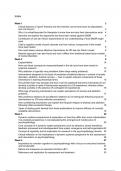Samenvatting
Summary Understanding Psychopathology: (most recent) Learning Objectives
The literature and lectures applied to the learning objectives! This is the most recent version since the learning objectives and literature have changed.
[Meer zien]




